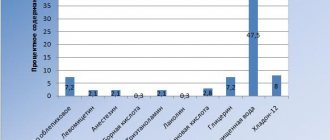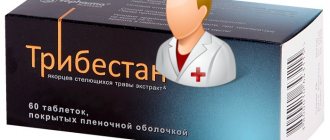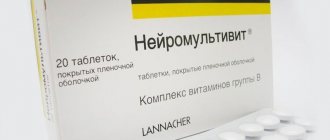Release form, composition and packaging
Gelatin capsules, size No. 1, with a purple body and a red cap; the contents of the capsules are white to yellowish-white powder.
| 1 caps. | |
| clindamycin (hydrochloride) | 150 mg |
Excipients: corn starch, lactose monohydrate, talc, magnesium stearate.
Composition of the capsule body: azorubine dye (E122), brilliant black dye (E151), gelatin. Capsule cap composition: titanium dioxide (E171), quinoline yellow dye (E104), azorubine dye (E122), crimson dye Ponceau 4R (E124), brilliant black dye (E151), gelatin.
8 pcs. - blisters (2) - cardboard packs.
The solution for intravenous and intramuscular administration is clear, colorless or slightly yellowish.
| 1 ml | 1 amp. | |
| clindamycin (as phosphate) | 150 mg | 300 mg |
Excipients: benzyl alcohol, disodium edetate, water for injection.
2 ml - ampoules (5) - contour cell packaging (2) - cardboard packs.
Clindamycin - instructions for use, price, reviews and analogues
Clindamycin is an antibacterial agent with a broad antimicrobial spectrum of action, belonging to the lincosamide group. It is used for bacterial infections in adults and children. The drug is not effective for viral pathology.
International name
The name of the antibiotic in Latin is Clindamycin.
The ATC (Anatomical Therapeutic Chemical Classification) code for the drug is D10AF51. Group – D10AF.
Release forms and composition
The medicine is produced in gelatin capsules of 150 mg, in the form of a cream, suppositories for insertion into the vagina (Clindacin) and a solution in ampoules of 300 mg.
The antibiotic is available in the form of a clear, colorless or slightly yellowish solution.
Solution
The antibiotic is available in the form of a clear, colorless or slightly yellowish solution. In finished medicines it is presented in the form of phosphate. The amount of active ingredient in 1 ml of solution is 150 mg. Additional components of the solution are disodium edetate, alcohol and water. The drug is placed in 2 ml ampoules, which are placed in packaging with cells or cardboard packs.
Capsules
Antibiotic capsules are size No. 1, with a purple body and a red cap. Contents: white powder. The antibiotic in capsules is presented in the form of hydrochloride.
The auxiliary components of the drug are: lactose, talc, magnesium stearate and corn starch. The cap contains titanium dioxide, quinoline yellow and Ponceau 4R crimson dye.
The body contains gelatin, azurobine and black dye. The capsules contain 150 mg of antibiotic.
Antibiotic capsules are size No. 1. The capsules contain 150 mg of antibiotic.
The antibiotic is used in the form of vaginal suppositories having a cylindrical-conical shape. Color – from white to slightly yellowish. There are no inclusions on the longitudinal section of the suppositories. The active substance in suppositories is presented in the form of phosphate. Auxiliary components are semi-synthetic glycerides. 1 suppository contains 100 mg of antibacterial agent.
Ointment
The antibiotic is not available in the form of an ointment, but is used in the form of a gel and a 2% white vaginal cream. The auxiliary components of the medicine are: sodium benzoate, castor oil, polyethylene oxide and propylene glycol. The cream is sold in aluminum tubes. One dose (5 g) contains 100 mg of antibiotic.
The antibiotic is used in the form of a gel and a 2% white vaginal cream.
pharmachologic effect
This antibiotic acts on many microorganisms. It is effective against Gram-stained and non-Gram-stained bacteria. The medicine has a bacteriostatic effect, that is, it inhibits the growth and reproduction of microbes in tissues. The mechanism of antibacterial action is associated with disruption of protein formation.
Staphylococci (including epidermal), streptococci, enterococci, peptococci, peptostreptococci, the causative agent of botulism, bacteroides, mycoplasmas, ureaplasmas, bacilli and anaerobes that are not capable of forming spores are sensitive to the drug. This drug is similar in its therapeutic effect to Lincomycin.
Pharmacokinetics
Absorption of the drug in the stomach and intestines occurs quickly and completely. Eating slows down absorption. The medicine easily enters and distributes into the tissues. The antibiotic enters the brain in small quantities.
The antibiotic enters the bloodstream most quickly when administered into a vein.
The largest amount of medicine is in the blood after 1 hour (when using capsules), after 1 hour (when administered into the gluteal muscle) in children and after 3 hours in adults.
The antibiotic enters the bloodstream most quickly when administered into a vein. The medication in therapeutic concentration remains in the blood for 8-12 hours. The drug is metabolized in the liver tissues.
The medicine is excreted by the kidneys in the urine and intestines along with feces.
Indications for use
Diseases for which the drug can be prescribed are:
- Infections of the ENT organs (inflammation of the pharynx, larynx, ear, paranasal sinuses, lungs, bronchi, abscesses), respiratory pathologies.
- Scarlet fever.
- Diphtheria.
- Diseases of the genitourinary organs (damage to the uterus, vulvovaginitis, colpitis, salpingoophoritis, chlamydia).
- Staphyloderma, pyoderma, abscesses, peritonitis.
- Septicemia (blood poisoning without purulent damage to internal organs).
- Purulent inflammation of bone tissue (osteomyelitis).
- Bacterial endocarditis (inflammation of the inner lining of the heart with damage to the valves).
The medicine can be prescribed for prophylactic purposes for injuries and perforation of the intestinal wall. In this case, preference is given to intramuscular or intravenous injections.
Contraindications
The instructions state the following contraindications to the use of the medicine:
- myasthenia gravis (muscle weakness);
- allergy to drugs based on clindamycin and Lincomycin;
- asthma;
- ulcerative form of colitis (inflammation of the colon);
- pregnancy (it is safe to use the cream in the 2nd and 3rd trimesters);
- lactation period;
- age up to 3 years (for solution);
- age up to 8 years or child weight less than 25 kg (for capsules).
The elderly and people should take the medicine with caution.
The elderly and people with renal and hepatic pathologies should take the medicine with caution.
For children over 15 years of age and adults, it is recommended to take the antibiotic 1 capsule every 6 hours. In severe cases, the doctor may increase the dosage. Injections should be done twice a day (2 times 300 mg). When treating patients over 3 years of age, the dosage is 15-25 mg/kg/day.
In case of liver and kidney dysfunction, as well as in case of long intervals (8 hours or more), no dose adjustment is required.
Taking the drug for diabetes mellitus
For diabetes mellitus, the antibiotic is used both in the form of oral agents and in the form of suppositories for intravaginal administration and solution. During treatment, it is recommended to monitor blood sugar levels.
Side effects
Most often they are reversible and disappear when treatment is stopped.
For diabetes mellitus, the antibiotic is used in the form of oral medications.
Gastrointestinal tract
When using Clindamycin, the following are possible:
- dyspepsia (digestion in the form of diarrhea, nausea);
- signs of inflammation of the esophagus (difficulty swallowing, heartburn, pain);
- yellowness of the skin;
- excess of normal levels of liver enzymes;
- increased concentration of liver enzymes in the blood;
- increased concentration of bilirubin in the blood;
- intestinal dysbiosis.
Sometimes patients develop pseudomembranous colitis.
When using the drug, dysbacteriosis is possible.
Blood-forming organs
The following changes are possible in the blood and hematopoietic organs:
- drop in white blood cell levels;
- decrease in neutrophils;
- agranulocytosis;
- drop in platelet levels.
From the cardiovascular system
If the drug enters the vein too quickly, dizziness, decreased blood pressure, collapse and weakness are possible.
From the musculoskeletal system
Occasionally, there is a disturbance in the transmission of impulses from nerves to muscles.
Allergies
The following types of allergic reactions are possible:
- urticaria (itchy rashes in the form of blisters on various parts of the body);
- maculopapular rash;
- dermatitis;
- eosinophilia (increased level of eosinophils in the blood);
- anaphylaxis (shock, Quincke's edema).
Possible allergies such as urticaria.
If pseudomembranous colitis is detected, ion exchange resins are effective. Antibiotic treatment must be stopped. If necessary, a drug based on metronidazole is used and infusion therapy is performed.
The instructions for use indicate that while taking Clindamycin you should not:
- use medications that impair intestinal motility;
- drinking alcohol;
- use other vaginal products (for creams and suppositories).
With long-term use of Clindamycin, like Erythromycin, the risk of activation of yeast-like fungi and the development of candidiasis increases.
Alcohol compatibility
Regardless of the daily dose, this drug should not be taken simultaneously with alcoholic beverages.
Impact on the ability to operate machinery
The antibiotic does not cause dizziness or movement disorders, so it does not affect control of machinery or driving a car.
Regardless of the daily dose, this drug should not be taken simultaneously with alcoholic beverages.
Clindamycin for children
When prescribing medication to children, their age and body weight are taken into account. Capsules cannot be used up to 8 years, and the solution - up to 3 years.
Use during pregnancy and lactation
Medicine in the form of solution and capsules is contraindicated during pregnancy. Vaginal cream can only be used for strict indications, when the possible benefits of treatment outweigh the potential harm to the fetus. In the first 3 months of gestation, suppositories are not prescribed, since during this period the vital organs of the child are formed.
The use of Clindamycin in cream form during lactation and breastfeeding is possible taking into account the possible risks.
Use in old age
The drug for injection and oral use in old age should be used with extreme caution.
Overdose
If you exceed the daily dose of the drug, undesirable effects may increase. An overdose occurs with abdominal pain, fever and other symptoms. Hemodialysis (blood purification) is ineffective in this case. Patients are prescribed symptomatic medications. There is no antidote. An overdose of medicine in the form of cream or suppositories is extremely rare.
If you exceed the daily dose of the drug, fever may occur.
This drug enhances the therapeutic effect of the following drugs:
- aminoglycosides (Streptomycin, Gentamicin);
- rifamycin derivatives (Rifampicin);
- muscle relaxants.
The simultaneous use of this antibiotic with Ampicillin, magnesium, barbituric acid derivatives and calcium gluconate is prohibited. The antagonists of Clindamycin are Erythromycin and Chloramphenicol.
The medicine does not combine well with antidiarrheals, B vitamins and Phenytoin. If you use narcotic analgesics at the same time, breathing may stop.
Analogs
Analogues of the drug in the form of a cream are Dalacin, Clindes and Clindacin. All of them are indicated for gynecological pathology. Gels for external use are produced: Klindatop, Klenzit-S and Klindovit. They are indispensable in the complex treatment of acne.
There is also Clindacin B Prolong cream. It differs in that it includes the antifungal substance butoconazole nitrate, which expands the spectrum of antimicrobial action. An analogue of Clindamycin in solution form is Zerkalin. It clears the skin of acne and pimples, just like the drug Adapalene.
Conditions for dispensing from a pharmacy
The medicine is dispensed according to a doctor's prescription.
Price for Clindamycin
Capsules cost from 170 rubles, and the price of a solution based on this antibiotic is more than 600 rubles. The cream costs from 350 rubles, the preparation in the form of suppositories costs more than 500 rubles.
Storage conditions for the drug Clindamycin
The solution is stored in a darkened place at a temperature of +15…+25ºC. The place where the antibiotic is stored must be inaccessible to children. The medicine belongs to list B. Suppositories are stored under the same conditions, the room must be dry. When storing the cream, the temperature should not exceed 20ºC. Clindamycin-based gel (Clindatop) should not be frozen or stored in the refrigerator.
Antibiotics for rosacea: Doxycycline, Metrogyl, Trichopolum, Clindamycin, Hyoxysone, Zinerit
Azithromycin, Unidox, Vilprafen, Clindamycin, Ornidazole, Terzhinan, Klion D for gardnerellosis
Best before date
The cream, solution for injection and gel are stored for 2 years. The shelf life of suppositories and capsules is 3 years.
Reviews from doctors and patients about Clindamycin
Nikolay, 22 years old, Moscow: “Acne has been bothering me for several years now. The doctor recommended a drug based on clindamycin, Clindatop. Within a few weeks I felt an improvement: redness, itching decreased, and my skin became clearer. An excellent antibacterial medicine.”
Svetlana, 37 years old, Kaliningrad: “Bacterial vaginosis was recently discovered. I was concerned about discharge from the genital tract and menstrual irregularities. A clindamycin-based vaginal cream was prescribed. After a week of treatment, all symptoms of the disease disappeared. The tests are normal.”
Yulia, 43 years old, Novosibirsk: “I have been prescribing this drug in tablets to my patients for many years, especially for respiratory pathologies. Great medicine."
Source: https://SayDiabetu.net/lechenie/tradicionnaya-medicina/drygie-lekarstva/preparat-klindamicin/
pharmachologic effect
Clindamycin is a drug from the group of antibiotics - lincosamides, has a wide spectrum of action, is bacteriostatic, binds to the 50S ribosomal subunit and inhibits protein synthesis in microorganisms. Active against Staphylococcus spp. (including Staphylococcus epidermidis, producing penicillinase), Streptococcus spp. (excluding Enterococcus spp.), Streptococcus pneumoniae, anaerobic and microaerophilic gram-positive cocci (including Peptococcus spp. and Peptostreptococcus spp.), Corynebacterium diphtheriae, Clostridium perfringens, Clostridium tetani, Mycoplasma spp., Bacteroidesspp. (including Bacteroides fragilis and Bacteroides melaningenicus), anaerobic gram-positive, non-spore-forming bacilli (including Propionibacterium spp., Eubacterium spp., Actinomyces spp.).
Most strains of Clostridium perfringens are sensitive to clindamycin, but other types of clostridia (Clostridium sporogenes, Clostridium tertium) are resistant to the drug, therefore, for infections caused by Clostridium spp., an antibiogram is recommended.
According to the mechanism of action and antimicrobial spectrum, it is close to lincomycin (against some types of microorganisms, especially against bacteroids and non-spore-forming anaerobes, it is 2-10 times more active).
Pharmacokinetics
It is quickly and completely absorbed from the gastrointestinal tract; simultaneous food intake slows down absorption without changing the concentration of the drug in plasma. Easily penetrates into biological fluids and tissues (tonsils, muscle and bone tissue, bronchi, lungs, pleura, bile ducts, appendix, fallopian tubes, prostate gland, synovial fluid, saliva, sputum, wound surfaces); passes through the BBB poorly (with inflammation of the meninges, the permeability of the BBB increases). Cmax in the blood is achieved with oral administration after 0.75-1 hour, after intramuscular administration - after 1 hour in children and 3 hours in adults, with intravenous administration - by the end of the infusion.
At a therapeutic concentration, it circulates in the blood for 8-12 hours, T1/2 is about 2.4 hours; metabolized predominantly in the liver (70-80%) with the formation of active (N-dimethylclindamycin and clindamycin sulfoxide) and inactive metabolites; excreted within 4 days by the kidneys (10%) and through the intestines (3.6%) in the form of an active drug, the rest - in the form of inactive metabolites.
CLINDAMYCIN: DOSAGE
Orally, adults and children over 15 years of age (average child weight 50 kg and above) for moderate diseases are prescribed 1 capsule (150 mg) 4 times a day (every 6 hours).
For severe infections in adults and children over 15 years of age, the single dose can be increased to 2-3 capsules (300-450 mg).
For children from 8 years to 15 years old, the method of using capsules is shown in the table.
For intramuscular and intravenous administration, the recommended dose for adults is 300 mg 2 times a day. For severe infections - up to 1.2-2.7 g / day, divided into 3-4 injections. IM administration of a single dose exceeding 600 mg is not recommended. The maximum single dose for intravenous administration is 1.2 g over 1 hour.
Children over 3 years old - 15-25 mg/kg/day, divided into 3-4 equal doses. For severe infections, the daily dose can be increased to 25-40 mg/kg body weight, divided into 3-4 equal doses.
Patients with severe hepatic and/or renal insufficiency do not require adjustment of the dosage regimen if the drug is prescribed at intervals of at least 8 hours.
For intravenous administration, the drug is diluted to a concentration not exceeding 6 mg/ml; the diluted solution is administered intravenously over 10-60 minutes.
It is not recommended to administer the drug intravenously.
The dilution and duration of infusion are recommended to be carried out according to the scheme dose - volume of solvent - duration of infusion (respectively): 300 mg - 50 ml - 10 min; 600 mg – 100 ml – 20 min; 900 mg - 150 ml - 30 min; 1200 mg - 200 ml - 45 min. The following solutions can be used as a solvent: 0.9% sodium chloride solution and 5% dextrose solution.
Age of the child Average severity of the disease Severe degree of the disease Maximum daily dose From 8 to 12 years (average child weight from 25 to 40 kg) 1 capsule 4 times/day Not more than 600 mg/day (4 capsules) From 12 to 15 years (average weight child from 40 to 50 kg) 1 capsule 3 times/day 2 capsules 3 times/day Not more than 900 mg/day (6 capsules)
Rules of application
This medicine should be prescribed to patients by specialists. The dosage and form of the medication will be determined based on the following factors: type of infectious agent, age group of patients, presence of concomitant pathologies, etc.
| Capsule form | The drug should be taken orally, after or before meals. The capsule should be taken with water (1 tbsp), as its components provoke the excretion of fluid. If a person is diagnosed with a moderate infection, then experts prescribe one capsule 4 times a day for adults and young patients over 15 years of age. If a severe form of abscess infection is diagnosed, then patients need to take two capsules 4 times a day. In particularly severe cases, the dosage is set at 300 mg of medication twice a day for 10 days. When treating children aged 8-12 years, doctors prescribe one capsule 4 times a day. Children who have not yet turned 8 years old are not prescribed medication in capsule form. |
| Injection solution | People are prescribed intramuscular injections of 300 mg of the drug 2 times a day. In case of severe infectious pathologies, the doctor may increase the dosage to 2.7 g up to 4 times a day. A single dose of medication should not exceed 600 mg. In the case when the drug will be administered intravenously to the patient, no more than 1.2 g of the drug should be infused within an hour. It is necessary to take a break of 8 hours between droppers and injections. Babies who are already three years old can receive injections. The dosage of the drug is determined based on body weight: 1 kg: 8-25 mg. The dose should be distributed over 3-4 injections |
| Suppositories | This medication is prescribed for infections of the ovaries, tubes, and cervix. Patients should administer one suppository vaginally for 3-7 days. |
| Ointment form | The creamy substance is indicated for use for vaginal infections. Patients should use an applicator to insert the cream into the vagina once a day before going to bed. Duration of therapy is 7 days |
| Gel form | The gel-like substance is used in the treatment of skin pathologies. The medicine should be applied directly to the lesions several times a day. The course of external therapy is a maximum of 30 days |
| Combination of drugs | Experts often combine forms of this drug. For example, oral capsules and intramuscular injections. In case of pathological processes in the pelvic organs, intramuscular administration of the medication is prescribed for the first 6 days, and oral administration of the medication for the next 14 days |
Drug interactions
Clindamycin enhances (mutually) the effect of rifampicin, aminoglycosides streptomycin, gentamicin (especially in the treatment of osteomyelitis and the prevention of peritonitis after intestinal perforation).
Enhances the effect of competitive muscle relaxants, and also enhances muscle relaxation caused by n-cholinergic blockers.
Incompatible with ampicillin, barbiturates, aminophylline, calcium gluconate and magnesium sulfate.
Shows antagonism with erythromycin and chloramphenicol.
Simultaneous use with solutions containing B complex vitamins, aminoglycosides, and phenytoin is not recommended.
Co-administration with antidiarrheal drugs increases the risk of developing pseudomembranous colitis.
When used simultaneously with opioid (narcotic) analgesics, the respiratory depression they cause may increase (up to apnea).
CLINDAMYCIN: SIDE EFFECTS
From the digestive system: dyspepsia (abdominal pain, nausea, vomiting, diarrhea), esophagitis, jaundice, liver dysfunction, hyperbilirubinemia, dysbacteriosis, pseudomembranous enterocolitis.
From the musculoskeletal system: rarely - disturbance of neuromuscular conduction.
From the hematopoietic organs: leukopenia, neutropenia, agranulocytosis, thrombocytopenia.
Allergic reactions: rarely - maculopapular rash, urticaria, itching; in some cases, exfoliative and vesiculobullous dermatitis, eosinophilia, anaphylactoid reactions.
From the cardiovascular system: with rapid intravenous administration - a decrease in blood pressure, up to collapse; dizziness, weakness.
Local reactions: irritation, pain (at the site of intramuscular injection), thrombophlebitis (at the site of intravenous injection).
Other: development of superinfection.
Clindamycin-M - contraindications, side effects
Contraindications. Clindamycin-M should not be used in patients with sensitivity to clindamycin, lincomycin, or any other component of the drug.
The drug is not suitable for the treatment of meningitis because the concentration of antibiotic that is achieved in the cerebrospinal fluid is too low.
Typically, a dosage form such as capsules is not suitable for use in children under 6 years of age.
Side effects. Pseudomembranous colitis; agranulocytosis, neutropenia, thrombocytopenia, leukopenia, eosinophilia; esophageal irritation, esophagitis, stomatitis, soft feces, diarrhea, abdominal pain, vomiting, nausea; maculopapular exanthema, morbilliform exanthema, urticaria; deviations from the norm in biochemical indicators of liver function.
The use of clindamycin may lead to excessive growth of other intestinal microorganisms, in particular fungi.
Sometimes allergic reactions occur even after the first use.
Indications
- infectious and inflammatory diseases,
- caused by microorganisms sensitive to clindamycin;
- upper respiratory tract infections and ENT infections (pharyngitis,
- tonsillitis,
- sinusitis,
- otitis),
- lower respiratory tract (pneumonia,
- incl.
- aspiration,
- lung abscess,
- pleural empyema,
- bronchitis),
- scarlet fever,
- diphtheria;
- infections of the urogenital tract (chlamydia,
- endometritis,
- vaginal infections,
- tubo-ovarian inflammation);
- skin and soft tissue infections (infected wounds,
- abscesses,
- boils,
- felon),
- abdominal cavity (peritonitis,
- abscess),
- oral cavity;
- acute and chronic osteomyelitis;
- septicemia (primarily anaerobic);
- bacterial endocarditis;
- prevention of peritonitis and intra-abdominal abscesses after intestinal perforation or as a result of traumatic infection (in combination with aminoglycosides).
Clindamycin - tablets
Infectious inflammatory diseases are becoming increasingly difficult to treat with antibiotics, as most pathogenic microorganisms quickly become resistant to such drugs. An exception is Clindamycin - tablets have a very wide spectrum of activity against bacteria resistant to other types of antibiotics. At the same time, the medication is safe even with long-term use.
Instructions for use of Clindamycin tablets
The presented medicine is available in the form of capsules, each of which contains 150 mg of the active ingredient (clindamycin hydrochloride). The drug has pronounced activity against most known microbes; its mechanism of action is similar to Lincomycin, but is 2-10 times more effective.
It is worth noting that there are 2 types of pathogenic microorganisms that are resistant to the agent in question - Clostridium sporogenes and Clostridium tertium. Therefore, for infections caused by clostridia, it is necessary to do a preliminary antibiogram.
Indications for the use of Clindomycin tablets are any inflammatory pathologies caused by bacteria sensitive to the active component. Among them:
1. Diseases of the urogenital system:
- endometritis;
- tubo-ovarian inflammation;
- chlamydia;
- vaginal infections.
2. Diseases of the skin and soft tissues:
- abscesses;
- felon;
- infected wounds;
- boils.
3. Infections of the upper and lower respiratory tract, otolaryngological organs:
- tonsillitis;
- pharyngitis;
- sinusitis;
- pneumonia;
- otitis;
- lung abscess;
- bronchitis;
- pleural empyema;
- diphtheria;
- scarlet fever.
4. Abdominal pathologies:
- peritonitis;
- intra-abdominal abscess;
- perforation of the intestine as a result of infection after injury.
5. Oral lesions:
- stomatitis;
- gingivitis;
- gum abscess.
Capsules are also sometimes used in the following cases:
- septicemia;
- acute, chronic osteomyelitis;
- bacterial endocarditis;
- acne disease.
Before starting a course of therapy, you need to familiarize yourself with the list of possible side effects after taking Clindamycin:
- intestinal dysbiosis;
- dyspeptic disorders;
- liver dysfunction in combination with jaundice;
- esophagitis;
- enterocolitis;
- deterioration of the hematopoietic system;
- urticaria and papular rash;
- skin itching;
- dermatitis;
- anaphylactic reactions;
- decreased blood pressure;
- muscle weakness;
- dizziness;
- eosinophilia;
- neuromuscular conduction disorders;
- development of superinfection.
The problems listed above usually arise when the medicine is used incorrectly and the recommended doses are exceeded.
Dosage of Clindamycin tablets
Bacterial inflammation of mild to moderate severity involves taking the described drug 4 times a day, every 6 hours, 150 mg of the active substance (1 capsule).
If the lesion is severe or progresses rapidly, the dosage of Clindamycin should be increased to 300-450 mg - 2-3 tablets per dose.
It is important to note that the antibiotic is acceptable in the treatment of patients with insufficiency of kidney or liver function, even in a severe stage. Only the interval between taking capsules should be at least 8 hours.
Contraindications to Clindamycin tablets according to instructions
The medication in question should not be used in case of increased individual sensitivity to clindamycin, pregnancy or during lactation. There are also the following contraindications:
- bronchial asthma;
- galactose intolerance;
- myasthenia gravis;
- lactase deficiency;
- ulcerative colitis, including its history;
- glucose-galactose malabsorption.
Contraindications
- myasthenia gravis;
- bronchial asthma;
- ulcerative colitis (history);
- rare hereditary diseases,
- such as: galactose intolerance,
- lactase deficiency or glucose-galactose malabsorption (for capsules);
- pregnancy;
- lactation period;
- children under 3 years of age - for a solution for intravenous and intramuscular administration (due to the lack of data on the safety of the use of benzyl alcohol);
- children under 8 years of age for capsules (average child weight less than 25 kg);
- increased sensitivity.
Clindamycin is used with caution in patients with severe hepatic and/or renal failure and in elderly patients.
special instructions
Pseudomembranous colitis can appear both while taking clindamycin and 2-3 weeks after stopping treatment (3-15% of cases); manifested by diarrhea, leukocytosis, fever, abdominal pain (sometimes accompanied by the release of blood and mucus in the stool).
If these phenomena occur, in mild cases, it is sufficient to discontinue treatment and use ion exchange resins (colestyramine, colestipol); in severe cases, replacement of the loss of fluid, electrolytes and protein, and the appointment of oral vancomycin or metronidazole are indicated.
Do not use medications that inhibit intestinal motility.
The safety of the drug in children under 3 years of age has not been established. With long-term therapy, children need periodic monitoring of their blood count and liver function.
When prescribing the drug in high doses, monitoring the concentration of clindamycin in plasma is necessary.
Patients with severe liver failure need to monitor liver function (liver enzymes).
Description of Clindamycin cream and instructions for use
The drug Clindamycin has several forms, the most popular of which is Clindamycin cream. This drug is used as an antibacterial agent against vaginosis caused by bacterial microflora, and can not only relieve symptoms that cause discomfort, but also eliminate the disease itself.
Description of the drug
Clindamycin cream is a drug from the lincosamide group intended to suppress infectious processes.
Available in aluminum tubes of 20 and 40 g, which include an applicator convenient for vaginal administration, and packaged in a cardboard box. It has a characteristic odor and is creamy in color.
The main active ingredient in the cream: clindamycin.
Store away from sunlight, in a dry place with a temperature not exceeding 20 degrees, out of reach of children.
The main composition of Clindamycin cream
The cream is based on Clindamycin in the form of phosphate, which belongs to the lincosamide antibiotic series.
In addition, this cream contains the following components:
- macrogol 1500;
- sodium benzoate;
- emulsifier;
- propylene glycol with castor oil.
The excipients included in the cream are intended to enhance the properties of the main component and to give the medicinal product the consistency of a cream.
Indications for use of the cream
Due to the fact that Clindamycin cream is a drug with antibacterial properties, the greatest effect when using it can be obtained in the treatment of inflammatory processes of the vagina caused by a bacterial infection, namely bacterial vaginosis. In this disease, as a result of further development of the infectious process, the natural lactoflora of the vagina is replaced by aggressive pathological microflora.
For example, this remedy is used to treat vaginosis, the characteristic symptoms of which are copious discharge with an unpleasant odor. To diagnose the presence of vaginosis, a vaginal smear is examined, which can reveal the presence of pathogenic microflora and serve as a reason for treatment with Clindamycin cream.
Before you start using the drug, you must keep in mind the contraindications, which are as follows:
- the patient's age is under 18 years;
- individual intolerance to the active substance clindamycin or one of the auxiliary components of the cream;
- pregnancy in the first trimester;
- breastfeeding period.
The use of Clindamycin cream is prescribed for vaginal infections caused by certain types of staphylococci and streptococci. During treatment, it is necessary to take into account that in the case of existing microorganisms that are insensitive to the drug, namely yeast-like fungi, the effect of Clindamycin cream can provoke their increased development.
Instructions for use
Clindamycin vaginal cream is intended for intravaginal use in the treatment of inflammatory diseases occurring in the vagina, as well as as the main drug against bacterial vaginosis. For ease of use, the cream comes with an applicator, the filling of which will be equal to a single dose sufficient for treatment.
It is recommended to administer the drug using this applicator directly into the vagina. The procedure does not require significant effort or special skills. The applicator is attached to a tube of cream, after which it is filled. In this case, you need to lightly press on the tube of cream, but do not pull back the piston.
The resulting portion of the drug is administered into the vagina as indicated in the instructions attached to the drug. It's better to do this before you go to bed.
The whole process takes no more than a minute, since the applicator allows you to measure the required portion of the cream, which should not exceed 100 milligrams.
The course of treatment is determined by the attending physician and depends on the general condition of the body and the degree of development of the pathological process. On average, treatment lasts no longer than ten days.
The instructions warn that during treatment with Clindamycin cream, side effects may occur in the form of minor dysfunctions of the gastrointestinal tract or in the digestive or central nervous system. Although they disappear after the end of treatment, it is nevertheless better to be prepared for such a reaction from the body.
Clindamycin cream price
Today, the average price of the drug in the pharmacy chain ranges from 300 to 400 rubles. A significant difference in price arises due to different purchase prices and pharmacy markups. In budget pharmacies, Clindamycin cream can be purchased at a lower price.
Existing analogues
Clindamycin cream has several analogues that have the same composition and are prescribed for the same diseases.
- Dalacin is a cream based on a product similar in composition. It has an antibacterial effect and is used to treat vaginitis caused by bacteria. Effectively eliminates symptoms of pathology and foci of infection.
- Clindacin is a cream used for vaginosis. The basis of this product is clindamycin phosphate. It is not used for persons under the age of majority; it has a number of contraindications.
- Vagitsin is a cream whose main active ingredient is clindamycin phosphate. Has an antibacterial effect. Contraindicated for use in the presence of inflammatory processes in the intestines and colitis resulting from taking antibiotics.
Clindamycin cream, due to its antibacterial properties, has proven effective against various pathological microflora. Among similar drugs, it is most popular due to its unique properties.
Reviews of those who used Clindamycin cream
Source: https://okreme.ru/opisanie/klindamitsin-krem.html










